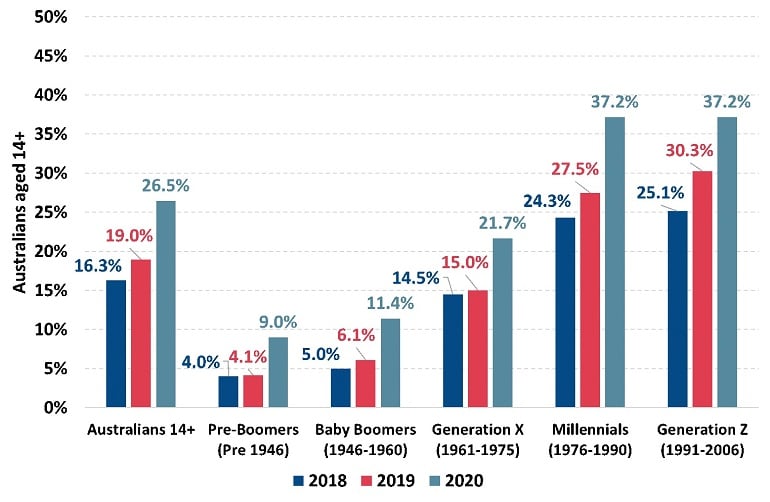The rise of meal delivery services over the last 12 months has been led by women, more than men, new research reveals.
More than a quarter of the population – 5.5 million people – have had their food brought to their door in 2020 according to new data from Roy Morgan Research, with a clear link between lockdowns and orders emerging over the last 12 months.
The national figure of 26.5% of all people aged over 14 using a meal delivery service last year has grown from 16.3% just two years earlier.
Women are higher users (27.9%) than men (24.9%) overall, and across every age group.
The highest usage for both genders is among millennials aged 25-34, with with figures well above the national average at 45.2% of women and 43.1% of men.
UberEats remains the market leader with around half of the total market share and is now used by 12.8% of Australians, including over 1-in-5 of both Generation Z and Millennials.
Other meal delivery services such as Menulog, Deliveroo and HelloFresh and DoorDash have also seen significant growth in their customer base during the pandemic period.
Unsurprisingly, it’s a capital city habit, with nearly a third (31.6%) of city-dwellers getting their meals delivered, nearly double the country town figure of 16.6%.
Lockdowns push growth
Victoria’s second, extended lockdown pushed Melbourne to the biggest user (36.1%), ahead of Sydney (31.7%) and Perth (29.0%).
Roy Morgan CEO Michele Levine said lockdowns were the perfect environment for the rapid growth of meal delivery service apps.
“Over a quarter of Australians used meal delivery services in 2020 and this spiked to well over a third of both Millennials and Generation Z (37.2% of both). These two generations account for almost 4 million users of meal delivery services – or over 70% of the current market,” she said.
“So far during 2021 there have been short lockdowns in Melbourne, Perth, Brisbane and a longer three-week localised lockdown of Sydney’s Northern Beaches and the threat of further lockdowns remains ever present – as the latest outbreak and seven-day lockdown in Melbourne shows.”
Levine said that older generations haven’t taken to using meal delivery services with the same gusto as their kids and grandkids.
“Around one-in-five of those in Generation X (21.7%) used meal delivery services in 2020 dropping to only 11.4% of Baby Boomers and just 9% of Pre-Boomers,” she said.
Levine said the ongoing pandemic will continue to support demand for meal delivery services for the rest of 2021 and even 2022 depending on the speed of Australia’s vaccine roll out, but there are headwinds building for the sector.
“The challenge for meal delivery services will come when the great majority of Australians have been vaccinated against the virus and our way of life begins to resemble what it was pre-COVID-19 on a sustainable basis,” she said.

The breakdown of food deliver growth in Australia over the last 3 years; Source: Roy Morgan




















Trending
Daily startup news and insights, delivered to your inbox.